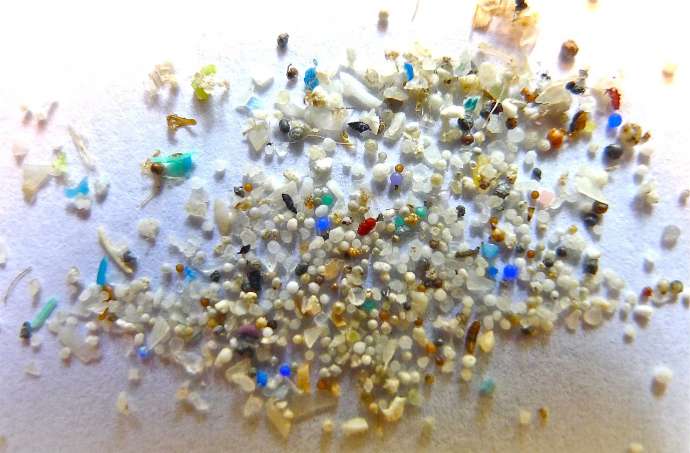Časoris is an online newspaper aimed at children. Each week we’ll take an article and post it here as a Slovene-English dual text.
Mikroplastika je povsod
Microplastics are everywhere
Written by Dora Adamič, translated by JL Flanner & G Translate
Onesnaženje s plastiko je eden izmed najbolj perečih problemov današnjega časa.
Plastic pollution is one of the most pressing problems of our time.
Plastiko namreč uporabljamo povsod.
Plastic is used everywhere.
Pomisli: tudi ti prideš vsak dan v stik s plastiko, kajne?
Think about it: you also come in contact with plastic every day, right?
Če ne drugega, ko si nadeneš lahko poletno majico iz poliestra.
If nothing else, when you put on a polyester summer shirt.
Plastika se ne more razgraditi, lahko le razpade na manjše delce, ki jim pravimo mikroplastika.
Plastic cannot decompose, it can only break down into smaller particles called microplastics.
Najdemo jo tudi v najbolj zakotnih kotičkih sveta – na Antarktiki, v jamah in celo na dnu oceanov.
It is also found in the most remote corners of the world – in Antarctica, in caves and even on the ocean floor.
Prav sintetična oblačila so eden izmed največjih virov mikroplastike.
Synthetic clothing is one of the biggest sources of microplastics.
Med pranjem se obrabljajo, ob tem pa se majhni plastični delci spirajo v kanalizacijo.
They wear out during washing, and small plastic particles then enter the sewer.
Ko pride mikroplastika v okolje, hitro vstopi predvsem v morske organizme. Prenaša se po prehranjevalni verigi.
When microplastics enter the environment, they mostly quickly enter marine organisms. They are then transmitted through the food chain.
Najvišje koncentracije najdemo v ribah, ki so na koncu prehranjevalne verige.
The highest concentrations are found in fish that are at the end of the food chain.
Za zdaj še ne vemo veliko o vplivih mikroplastike na zdravje. Vendar veliko raziskav nakazuje, da so lahko ti dolgoročni. Preučevanje dolgoročnih učinkov je veliko zahtevnejše, saj se pojavijo šele po nekajletni izpostavljenosti.
We do not yet know much about the health effects of microplastics. However, much research suggests that these may be long term. The study of long-term effects is much more demanding, as they appear only after several years of exposure.
Plastika prej ali slej pride tudi v naša telesa.
Plastic sooner or later also enters our bodies.
Povprečen človek s hrano in vodo tedensko zaužije pet gramov plastičnih delcev. To je približno v velikosti bančne kartice.
The average person consumes five grams of plastic particles a week with food and water. This is about the size of a bank card.
Največ mikroplastike vdihnemo z zrakom.
Most microplastics are inhaled with air.
Z obrabo različnih sintetičnih oblačil in drugih materialov se v zrak sproščajo mikroplastični delci, ki se lahko kopičijo v naših pljučih.
Wearing various synthetic clothing and other materials releases microplastic particles into the air, which can accumulate in our lungs.
Trenutno še ne poznamo učinkovitih načinov odstranjevanja ali razkrajanja plastike.
We do not yet know any effective ways to remove or decompose plastic.
Zato moramo ugotoviti, kako preprečiti, da bi mikroplastika zašla v okolje in naša telesa.
Therefore, we need to figure out how to prevent microplastics from entering the environment and our bodies.
Najrazličnejša podjetja že razvijajo posebne filtre za pralne stroje in čistilce zraka, ki bi filtrirali mikroplastiko.
A variety of companies are already developing special filters for washing machines and air purifiers to filter microplastics.
Read more stories and improve your Slovene at Časoris, while all our dual texts can be found here.






